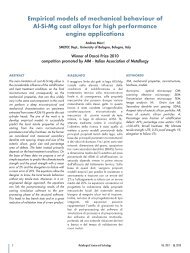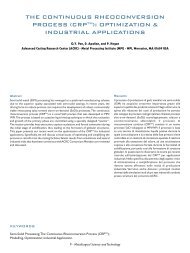PDF, about 5Mb - Teksid Aluminum
PDF, about 5Mb - Teksid Aluminum
PDF, about 5Mb - Teksid Aluminum
You also want an ePaper? Increase the reach of your titles
YUMPU automatically turns print PDFs into web optimized ePapers that Google loves.
A) B)<br />
C) D)<br />
Fig. 7: Microstructure of the AZ31 tested at: 200°C-10-2 s-1 (a) 300°C-10-2 s-1 (b) and 400°C- 1 s-1 (c); (d) 400°C-10-3 s-1 .<br />
7b). Fully recrystallization and localised grain<br />
growth at 400°C, in the high strain rate range,<br />
resulted in the presence of some large grains<br />
heavily deformed by twinning, albeit a relatively<br />
large fraction of the structure is composed by fine<br />
equiaxed grains. Under lower strain rate, the<br />
structure is composed by a homogeneous<br />
distribution of relatively coarse equiaxed grains<br />
(Figure 7d).<br />
The mechanism of dynamic recrystallization (DRX)<br />
has been analysed by McQueen and Konopleva<br />
[15]; twinning in fact takes place before the other<br />
mechanisms, except basal glide that occurs in<br />
favourably oriented grains. At low strains, twinning<br />
favourably reorients grains for slip. As deformation<br />
reaches a sufficiently high value, DRX starts where<br />
high misorientations have been created by<br />
accumulation of dislocations, i.e. where slip has<br />
occurred on several slip system (near grain<br />
boundaries and twins). The new fine grains form a<br />
mantle (or a “necklace”) along grain boundaries<br />
and deform more easily than the grain core, thus repeatedly undergoing<br />
recrystallization [12].<br />
Figure 8 shows typical micrographs of the microstructure of ZM21 tested<br />
in torsion. The structure, even at 300°C, is largely unrecrystallized, with<br />
elongated grains; at 400°C, the grains are mostly equiaxed, but elongated<br />
structures still persist. The strong decrease in flow stress after the peak<br />
should be attributed to the late onset (at strain close to ε=0.7-0.8) of<br />
recrystallization and coarsening phenomena, that in this alloy exhibit quite<br />
different kinetics than in the case of the AZ31. Only at the highest<br />
temperature (500°C), the microstructure underwent complete<br />
recrystallization and grain growth, a process that resulted in the presence<br />
of coarse (50 µm) grains.<br />
The above analysis gives some interesting preliminary indications on the<br />
high-temperature formability of the extruded ZM21 alloy. In particular:<br />
1. the intrinsic ductility, i.e. the equivalent failure strain in torsion, is lower<br />
in ZM21 than in AZ31;<br />
2. the fraction of recrystallized structure, at all the investigated<br />
temperatures, is lower in ZM21 than in AZ31;<br />
3. the maximum equivalent stress, i.e. the working load, is higher in AZ31<br />
than in ZM21; yielding has been observed in ZM21, thus suggesting a<br />
solute strengthening role played by either Zn or Mn;<br />
28 - Metallurgical Science and Technology







